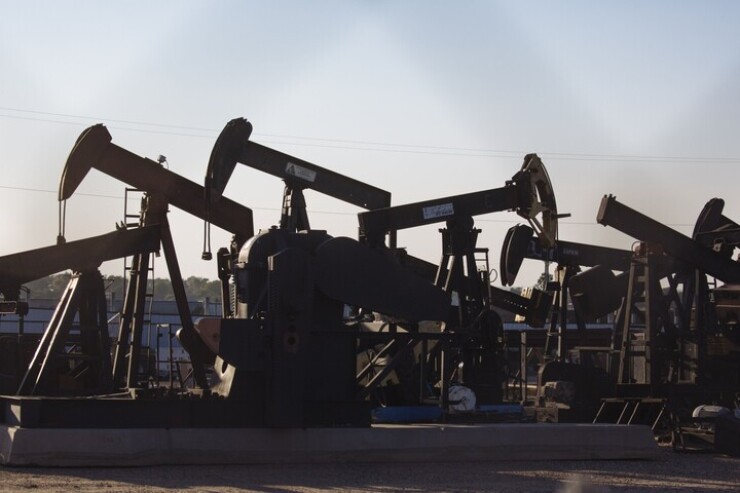Abundant oil and natural gas-related taxes continue to flow into the coffers of Southwest states, which are positioned to weather volatile energy prices amid slower growth in overall tax revenue.
Fitch Ratings in a recent report said it doesn't expect any negative rating implications for energy producing states directly resulting from short-term declines in oil and natural gas prices as severance tax revenue is linked to natural resource extraction volume and price.
"I don't think that a temporary softening of prices in the market really presents any kind of any kind of credit pressure," said Michael D'Arcy, a Fitch analyst who authored the report.

He said energy producing states have budgeted for weaker fiscal 2024 severance tax revenue, and states including Texas, Oklahoma and New Mexico have built up strong reserves.
Severance tax collections in Texas and Oklahoma "clearly topped out" in the first quarter, although higher crude oil prices are expected next year, according to a BofA Global Research report.
"Our commodities analysts expect (West Texas Intermediate crude oil) to average $75 (per barrel) this year, down from roughly $96/bbl last year, before averaging $85/bbl in 2024," the report said.
In Oklahoma, which ended fiscal 2023 on June 30, gross revenue of $17.44 billion rose 6% compared to fiscal 2022, which saw revenue growth of 15% over fiscal 2021. Slowing growth was the most evident in oil and gas gross production taxes, which were up nearly 20% at a record $1.83 billion versus a jump of 102.8% that produced a then-record $1.53 billion in fiscal 2022.
In his monthly revenue report, State Treasurer Todd Russ noted June oil and gas taxes were down 42.7% versus June 2022, "which indicates the downward trend of energy prices."
S&P Global Ratings, which revised the outlook on Oklahoma's AA general obligation and AA-minus appropriation-backed bond ratings to positive from stable last week, said "revenues generated directly from gross oil and gas production and indirectly from individual income and sales tax conditions greatly improved the state's overall financial health over the past three fiscal years."
The rating agency added there is a one-in-three chance it could upgrade Oklahoma's rating if in part the state demonstrates "a firm commitment to structurally balanced financial performance and sustaining reserves and liquidity at levels that we believe position the state to more readily respond to volatile swings within future budgets, particularly given that a higher proportion of the state's economy and revenue base are tied to cyclical global energy markets compared to the national average."
Fitch, which rates Oklahoma AA with a stable outlook, said the state has rebuilt its rainy day fund to a constitutionally capped 15% of fiscal 2022 general fund collections, while also increasing other statutory reserves.
Oil and natural gas production in Texas and parts of Louisiana and New Mexico grew in 2023's second quarter but at a slower pace than in the first quarter, according to a Federal Reserve Bank of Dallas energy survey released in June.
"Weak oil and gas prices along with high costs brought growth in oil and gas activity to a standstill in the second quarter, according to respondents of our latest energy survey," Michael Plante, Dallas Fed senior research economist and advisor, said in a statement.
Severance tax collections in triple-A-rated Texas, which is projecting it will end fiscal 2023 on Aug. 31
In fiscal 2022, Texas severance taxes generated a record $10.83 billion and had the highest annual growth rate of nearly 116%.
"Texas can kind of shrug off these energy market travails now because its economy has diversified so much," D'Arcy said.
Meanwhile, growth in sales taxes, the biggest revenue source for the Texas budget, has been moderating, with May's 4.1% increase over May 2022 marking the lowest annual rate of increase in the 26 months since the end of pandemic restrictions, State Comptroller Glenn Hegar reported. Sales tax collections in the first 10 months of fiscal 2023 were still 9.74% higher than the same period in fiscal 2022.
"This slower growth is expected and in line with the economic outlook we detailed in our biennial revenue estimate, as both the rate of inflation and growth in real economic activity slow as demand cools in the face of higher interest rate policy and reduced fiscal stimulus from the federal government," Hegar said in his report on May revenue.
The oil and natural gas industry in Texas contributed a record $24.7 billion last fiscal year in state severance and local property taxes, as well as royalties and other payments,
Leases and royalties from the industry flow into state funds that support billions of dollars of bonds – the
Earlier this year, the latter was able to greatly expand capacity in its bond guarantee program, which bestows triple-A ratings on school debt, after the U.S. Internal Revenue Service changed a formula
Projected available capacity, which fell as low as $26.6 million at the end of last year,
New Mexico's Legislative Finance Committee has not reported revenue collections since February, when fiscal-year-to-date mineral production taxes were up 58.3%. Under a new state law, excess oil and gas revenue starting with an expected $587 million in fiscal 2025, growing to $1.2 billion in fiscal 2026, will be invested through the Severance Tax Permanent Fund instead of flowing into the general fund.
"By responsibly reinvesting the record revenues we are seeing now, we ensure that future budgets are less dependent on the current state of the oil and gas industry," Gov. Michelle Lujan Grisham said in a statement.
The excess revenue is projected to earn an average return of 5.7% with the permanent fund expected to grow from $8.2 billion in 2024 to $30 billion by 2035.
Analysts from PFM's management and budget consulting practice





